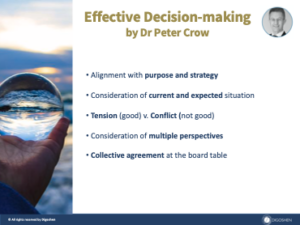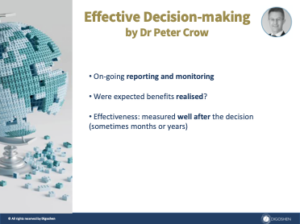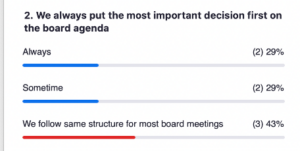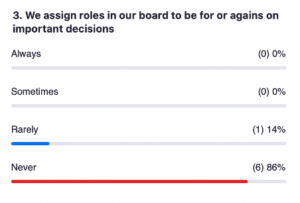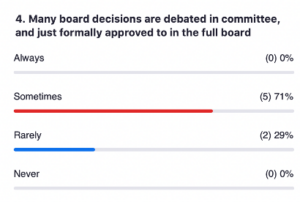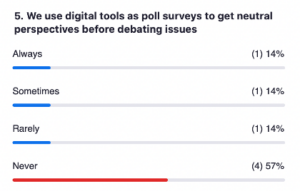Board’s decision making for the new normal
At the core, the board’s job is to ensure the performance of the enterprise it governs. For that is needs to make decisions, strategic decisions. This sounds straightforward, but many boards struggle to make good decisions.
”Only one in three boards reliably reach a conclusion”
Only one in three boards reliably reach a conclusion (make a decision) when considering an important matter, for example; and only one in six directors understand the business of the business well. Given this research (see end of post) , and the trail of company failures and missteps, it’s little wonder that boards struggle.
”Only one in six directors understand the business of the business well”
Improvements to boards decisions making is certainly worth exploring, which we did in the recent Digoshen International Live Exchange.
Diogshen Impact Partner Dr Peter Crow helped us revisit the topic prior to our discussions.
Considerations for more effective decision-making:
We explored with our practicing board members the current status and what could be improved.
How do you prepare, how much time is spent debating alternatives and how do you make sure that the focus of the board agenda is prioritising the most important decisions?
- About 10-25% of boards time time is spent to actually debate the options.
- But only 30% of us always make sure we put our most important decisions in the beginning of the board agenda,
Preparation and managing expectations: Directors should prepare well, which includes reading papers carefully, making other enquiries and asking in advance of the meeting. Also, the board chair should ensure adequate time is provided for healthy debate.
Check alignment: How does the proposal to be decided upon fit with the company’s purpose and strategy, and what are the expected benefits to be realised?
Analyse consequences carefully: Board members need to think holistically — systems thinking is crucial. Check a range of perspectives and the consequences of those, to ensure the effects and impact of the decision are known before the decision is taken. Also check the costs and impact of not making a decision, and the ‘do nothing’ option. Some options that look initially, may be determintal over the longer term.
How do you ensure different perspectives, how do you ensure that committee preparations are understood and decided by the full board?
Here we found some areas where we can improve.
- Rarely do we play devils advocates to test our assumptions, only 14% do it even rarely).
- Many preparations in subcommittees can be better reported back to board, as a whopping 71% are debated in the subcommittee and only formally approved with the full board.
- And we could also enhance input by applying digital tools before we debate options, which is only done by 30% more than sometimes.
Committees: The assessment of a proposal by a committee of the board is useful to ensure a more robust analysis and recommendation, leaving the full board to concentrate on higher-level risk and alignment questions.
Appoint a devil’s advocate: Allocating the advocatus dialobi role ahead of a debate can be useful to test assumptions and challenge various points of view. But it needs to be carefully managed by the board chair, to ensure its use does not descend into conflict between board members.
Be brave to postpone: Sometimes, it’s good to postpone a decision until better information is available.
Trust is fundamental: An open, trusting culture amongst directors is crucial, to support the exploration of multiple perspectives and high quality debate ahead of the decision.
Decisions are collective: The board is a collective of directors, and decisions are taken by the group, not individuals. Therefore, all directors need to agree with the decision, or offer their consensus at least. Otherwise, cliques may form and the effectiveness of the board as a decision-making group will be compromised.
We also noted that most boards can improve in ensuring that they follow up on the expected benefits.
Monitor and verify: Ensure post-decision reporting requirements are clearly defined, so that board and management can assess process towards the expected benefits (from the decision) is being achieved, or not.
Peter Crow helped us conclude on the decision making at boards
In the end, boards are social groups, and they operate within social settings, the company and with wider marketplace. Things can (and do) change quickly, so boards need to keep their eyes open for changes and take these into account to ensure their decisions are contextually relevant.
Learn more
To dive deeper into the topic, read this research and articles
Learn more from Digoshen
If you are a practicing board member that want to find a safe ground to discuss the boards guidance of corporate renewal, welcome to join the open Digoshen International Live Exhanges and you can also apply to join the Digoshen International board Exchange Membership.
You will meet several of Digoshen’s Impact Partners, all practicing board members, and several are thought leaders on the topic of innovation and boards.
At Digoshen we amplify the voices and impact of purpose-driven leaders, which are needed to unleash the ocean of business & digital opportunities needed to create a better world.
We also support leaders and companies in removing #businessblindspots and #digitalblindspot. To assess your situation as leader and company, take our survey and get a free of charge personalized report with recommendations on how to move forward. The survey is anonymous and takes about 15 minutes to complete.
You are welcome to find insights from Digoshen Think Tank with Research, Insight Blog, Live Exchange Webinars, Exploring Leaders Podcast and Recommended Podcasts or our Social Wall or Calendar.
Welcome to follow Digoshen at LinkedIn, Twitter, Facebook and Youtube, or follow one of our Digoshen Impact Partners


